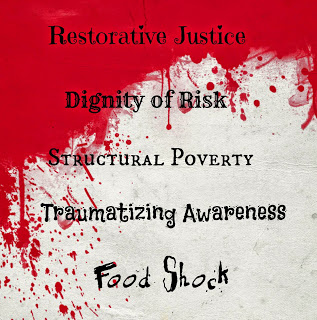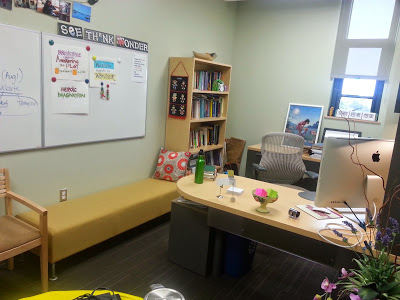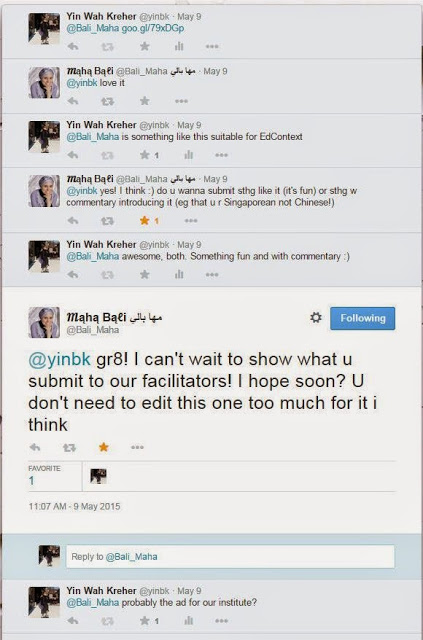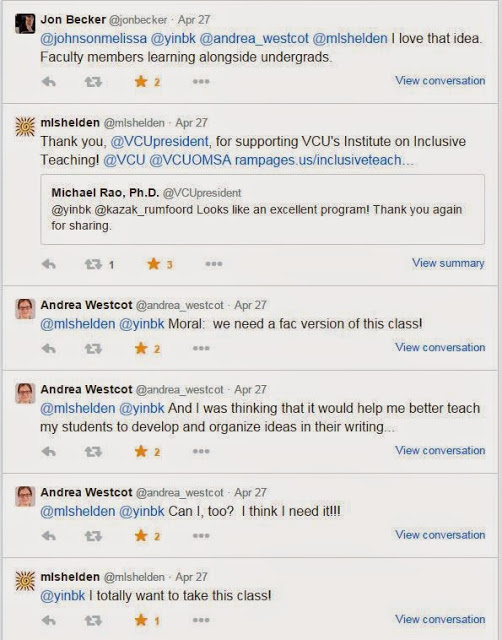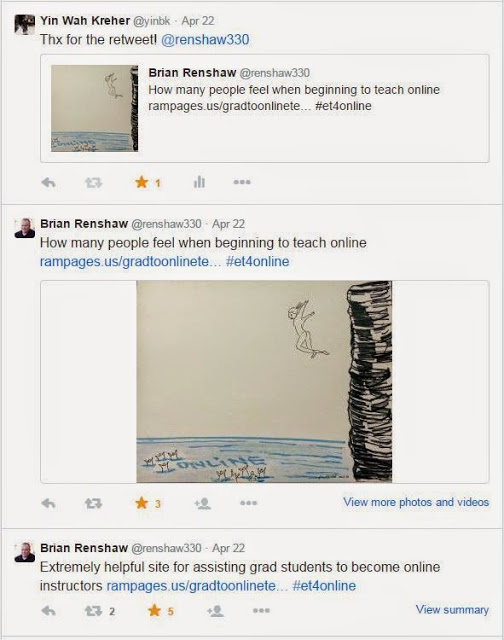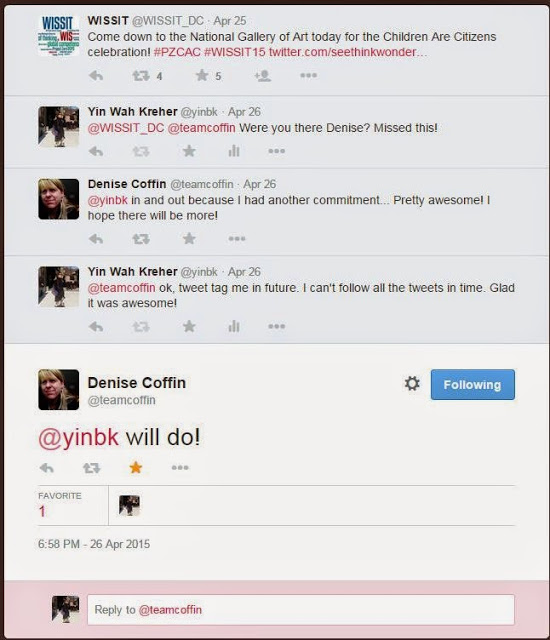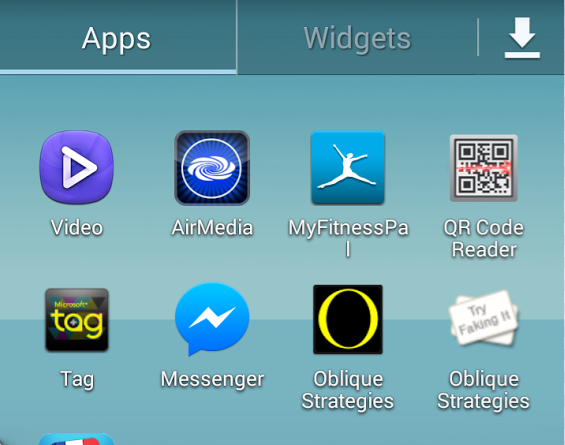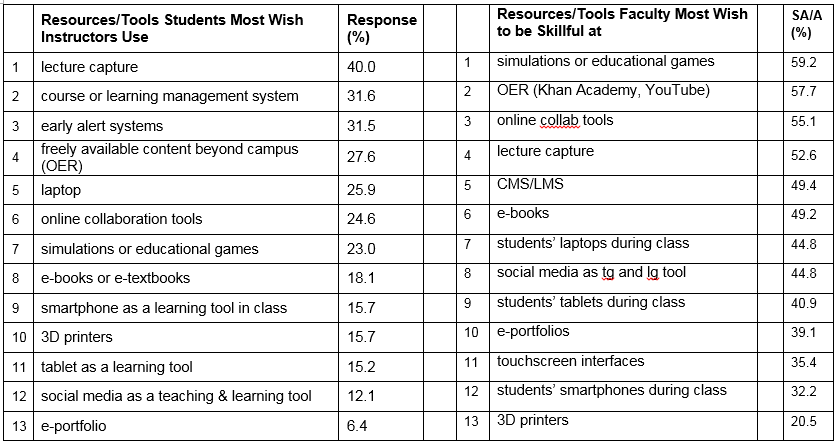This is How I Tweet and Chirp
I use Twitter as part of my work and for professional development. I created an account in 2007 but wasn’t actively participating in the web until ALT Lab came along. I have ways to go but there are several things I’ve learned from using Twitter actively since October 2014. I’ve summarized and illustrated them as 7 big ideas thus far.
- I get the latest information from my Tweeps/Twends? (Twitter People/Twitter Friends)
- My Twends tutor me when I need some help.
- I reflect and wonder out loud on Twitter.
- Let’s not forget the social aspect. Many of my Twends are warm and helpful.
- It’s not all serious stuff for me. Twitter brightens up a dull day with its jokes and funny tweets….
- And clever ideas abound.
- I don’t just wonder out loud. I reflect and share my written thoughts on Twitter.
But the biggest takeaway for me is that Twitter is all about participation. The more you participate in activities and connect with others, the more you will get out of it and the more you want to be in a position to give back to others for being so giving to you. So participate, connect, share and give back. Be authentic and courageous. Loosen up a bit and have fun!
1. I get the latest information from my Tweeps/Twends? (Twitter People/Twitter Friends)
For example, I’m interested in Reggio-inspired Visible Thinking and what Project Zero (at Harvard) is up to. I want to know the latest professional development opportunities and conferences they offer.
I didn’t think I’d see this show up on Twitter but it did – Thinking Routines!
What are #Thinking Routines? This video explains what they are & how to use them: http://t.co/QkTOv7CkPj @contemplatethis #PZATL #edchat
— Project Zero (@ProjectZeroHGSE) May 8, 2015
Slow down to understand complexities by Shari Tishman http://t.co/m2UrSQs9dk #PZATL
— Ilse Ortega (@ilseort) May 9, 2015
Slowly as more thought leaders sign up on Twitter, I am able to get the latest information about their recent presentations and writings via Twitter. As a boundary crosser, my interests span education, instructional design, visible thinking, inclusive learning design, arts, French, leadership and creativity. Having been a teacher for many years of my life, at heart, I still see myself very much as a teacher. I participate in Twitter chats like the #satchatwc, #UDLchat, and any that I sometimes stumble across that interests me.
Our very own ALT Lab #TJC15 (Twitter Journal Club, run by @googleguacamole) chat is one I very much enjoy. Although I don’t do research as much as I used to, I miss reading about the latest research in education. Twitter chats meet my need for shared community and online engagement beyond the posting of solitary tweets.
I even got the chance to contribute to a radio play and read a few lines. Talk about fun!
Keep your ears open for the premiere of the #rhizo15 Radio Play: Collaboratively Written/Collaboratively Performed pic.twitter.com/1X3uCsDk2B
— KevinHodgson (@dogtrax) April 25, 2015
There are opportunities to write articles. I was honored to be invited to write a blogpost by a Twitter friend, Maha Bali who runs EdConteXts with a group of colleagues.
2. My Twends tutor me when I need some help.
I struggle to learn French at my grand old age, but I have a couple of Twends (Nadia, and Tania Sheko) who will jump in to help me. (I do curate a vast amount of resources but nothing beats a live tutor.)
There are too many people to mention who have taught me and tutored me (see blogpost on Hypothes.is which was introduced to me by Greg McVerry). Pardon me if I fail to mention all of you in this blogpost. All my Twends from #rhizo15, #et4online, #satchatwc, #udlchat, folks from #a11y where I’ve been lurking… Thank you from the depths of my heart!
3. I reflect and wonder out loud on Twitter.
Sometimes, someone will pick up my idea, join me in an extended conversation and provide fresh perspectives and resources on the idea.
@yinbk @mlshelden interesting idea. Some would say they enable but not guarantee wider collaboration. Why exclusive?
— Simon Warren (@worried_teacher) April 23, 2015
Even when I couldn’t present at a conference, I received some feedback about my presentation via Twitter.
4. Let’s not forget the social aspect. Many of my Twends are warm and helpful.
After all, Twitter is part of social media.
You get to connect with new and old friends.
5. It’s not all serious stuff for me. Twitter brightens up a dull day with its jokes and funny tweets….
Ryan McHenry had a great sense of humor. The”@RyanGosling Won’t Eat His Cereal” guy couldn’t ask for a better tribute http://t.co/4DZqmAzcLH
— Ellen DeGeneres (@TheEllenShow) May 5, 2015
6. And clever ideas abound.
— Joe Dillon (@onewheeljoe) May 2, 2015
Are you using cinemagraphs in #elearning? http://t.co/3SvKVS7DKO #elhchallenge #edtech pic.twitter.com/EdTsvGmwwR
— Melissa Milloway (@MelMilloway) May 1, 2015
@yinbk You’re welcome. I did make some too! Not too difficult http://t.co/sU7aDDIWiz
— Melissa Milloway (@MelMilloway) May 8, 2015
7. I don’t just wonder out loud. I reflect and share my written thoughts on Twitter.
I blog and share reflections of my work on Twitter. This doesn’t get me much feedback but I see that sometimes, some tweeted blogposts get more hits than blogposts that I don’t disseminate via Twitter.
I can ramble on. This is my first draft and I’ll likely revise it a bit. It’s amazing how much I have learned from Twitter and am learning to give back to my Twends. Merci all!
